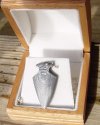- Joined
- Jul 8, 2002
- Messages
- 1,240
Hey all, another off topic question for ya.
I have the damacus pieces for my next pen turned down to size and bored. This only leaves about a 0.020 wall thickness at the thinest point of one tube. The other is not tapered and has a consistant wall thickness of 0.036.
I was planning on heat treating the pieces but now I am wondering if that would be a good thing to do or not. That is thicker than what my blades are before HT, but it is just a rough finish from the drill bit on the inside diameter. Plus, I don't know what kind of distortion I will get from HT on my final turned dimensions. Right now I am as far away from perfect as I want to get, any more will degrade the fit and finish.
The only reason i wanted to was because I think HT'd damascus looks better when etched, than un HT'd material.
So, do I heat treat or not?
I have the damacus pieces for my next pen turned down to size and bored. This only leaves about a 0.020 wall thickness at the thinest point of one tube. The other is not tapered and has a consistant wall thickness of 0.036.
I was planning on heat treating the pieces but now I am wondering if that would be a good thing to do or not. That is thicker than what my blades are before HT, but it is just a rough finish from the drill bit on the inside diameter. Plus, I don't know what kind of distortion I will get from HT on my final turned dimensions. Right now I am as far away from perfect as I want to get, any more will degrade the fit and finish.
The only reason i wanted to was because I think HT'd damascus looks better when etched, than un HT'd material.
So, do I heat treat or not?

